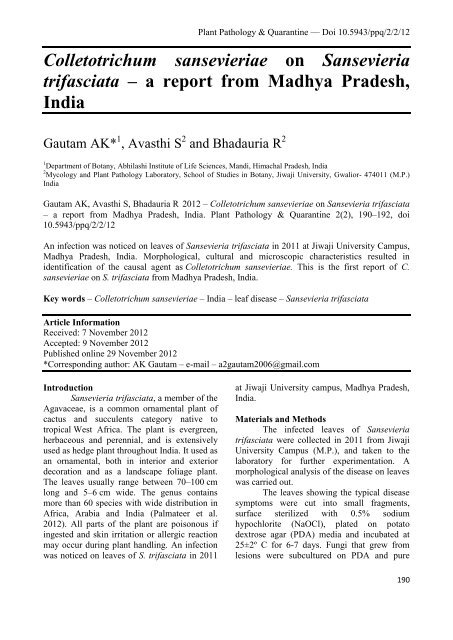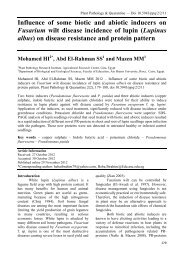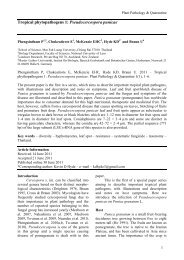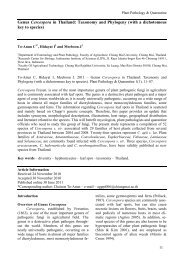Colletotrichum sansevieriae on Sansevieria trifasciata – a report ...
Colletotrichum sansevieriae on Sansevieria trifasciata – a report ...
Colletotrichum sansevieriae on Sansevieria trifasciata – a report ...
Create successful ePaper yourself
Turn your PDF publications into a flip-book with our unique Google optimized e-Paper software.
Plant Pathology & Quarantine — Doi 10.5943/ppq/2/2/12<br />
<str<strong>on</strong>g>Colletotrichum</str<strong>on</strong>g> <str<strong>on</strong>g>sansevieriae</str<strong>on</strong>g> <strong>on</strong> <strong>Sansevieria</strong><br />
<strong>trifasciata</strong> <strong>–</strong> a <strong>report</strong> from Madhya Pradesh,<br />
India<br />
Gautam AK* 1 , Avasthi S 2 and Bhadauria R 2<br />
1 Department of Botany, Abhilashi Institute of Life Sciences, Mandi, Himachal Pradesh, India<br />
2 Mycology and Plant Pathology Laboratory, School of Studies in Botany, Jiwaji University, Gwalior- 474011 (M.P.)<br />
India<br />
Gautam AK, Avasthi S, Bhadauria R 2012 <strong>–</strong> <str<strong>on</strong>g>Colletotrichum</str<strong>on</strong>g> <str<strong>on</strong>g>sansevieriae</str<strong>on</strong>g> <strong>on</strong> <strong>Sansevieria</strong> <strong>trifasciata</strong><br />
<strong>–</strong> a <strong>report</strong> from Madhya Pradesh, India. Plant Pathology & Quarantine 2(2), 190<strong>–</strong>192, doi<br />
10.5943/ppq/2/2/12<br />
An infecti<strong>on</strong> was noticed <strong>on</strong> leaves of <strong>Sansevieria</strong> <strong>trifasciata</strong> in 2011 at Jiwaji University Campus,<br />
Madhya Pradesh, India. Morphological, cultural and microscopic characteristics resulted in<br />
identificati<strong>on</strong> of the causal agent as <str<strong>on</strong>g>Colletotrichum</str<strong>on</strong>g> <str<strong>on</strong>g>sansevieriae</str<strong>on</strong>g>. This is the first <strong>report</strong> of C.<br />
<str<strong>on</strong>g>sansevieriae</str<strong>on</strong>g> <strong>on</strong> S. <strong>trifasciata</strong> from Madhya Pradesh, India.<br />
Key words <strong>–</strong> <str<strong>on</strong>g>Colletotrichum</str<strong>on</strong>g> <str<strong>on</strong>g>sansevieriae</str<strong>on</strong>g> <strong>–</strong> India <strong>–</strong> leaf disease <strong>–</strong> <strong>Sansevieria</strong> <strong>trifasciata</strong><br />
Article Informati<strong>on</strong><br />
Received: 7 November 2012<br />
Accepted: 9 November 2012<br />
Published <strong>on</strong>line 29 November 2012<br />
*Corresp<strong>on</strong>ding author: AK Gautam <strong>–</strong> e-mail <strong>–</strong> a2gautam2006@gmail.com<br />
Introducti<strong>on</strong><br />
<strong>Sansevieria</strong> <strong>trifasciata</strong>, a member of the<br />
Agavaceae, is a comm<strong>on</strong> ornamental plant of<br />
cactus and succulents category native to<br />
tropical West Africa. The plant is evergreen,<br />
herbaceous and perennial, and is extensively<br />
used as hedge plant throughout India. It used as<br />
an ornamental, both in interior and exterior<br />
decorati<strong>on</strong> and as a landscape foliage plant.<br />
The leaves usually range between 70<strong>–</strong>100 cm<br />
l<strong>on</strong>g and 5<strong>–</strong>6 cm wide. The genus c<strong>on</strong>tains<br />
more than 60 species with wide distributi<strong>on</strong> in<br />
Africa, Arabia and India (Palmateer et al.<br />
2012). All parts of the plant are pois<strong>on</strong>ous if<br />
ingested and skin irritati<strong>on</strong> or allergic reacti<strong>on</strong><br />
may occur during plant handling. An infecti<strong>on</strong><br />
was noticed <strong>on</strong> leaves of S. <strong>trifasciata</strong> in 2011<br />
at Jiwaji University campus, Madhya Pradesh,<br />
India.<br />
Materials and Methods<br />
The infected leaves of <strong>Sansevieria</strong><br />
<strong>trifasciata</strong> were collected in 2011 from Jiwaji<br />
University Campus (M.P.), and taken to the<br />
laboratory for further experimentati<strong>on</strong>. A<br />
morphological analysis of the disease <strong>on</strong> leaves<br />
was carried out.<br />
The leaves showing the typical disease<br />
symptoms were cut into small fragments,<br />
surface sterilized with 0.5% sodium<br />
hypochlorite (NaOCl), plated <strong>on</strong> potato<br />
dextrose agar (PDA) media and incubated at<br />
25±2º C for 6-7 days. Fungi that grew from<br />
lesi<strong>on</strong>s were subcultured <strong>on</strong> PDA and pure<br />
190
Fig. 1 <strong>–</strong> Leaf lesi<strong>on</strong>s from natural infecti<strong>on</strong><br />
Plant Pathology & Quarantine — Doi 10.5943/ppq/2/2/12<br />
191
cultures were maintained for further analysis<br />
Microscopic and cultural examinati<strong>on</strong>s were<br />
carried out for pathogen identificati<strong>on</strong>.<br />
Healthy leaves were pin-pricked and<br />
spray inoculated with a spore suspensi<strong>on</strong> (10 5<br />
c<strong>on</strong>idia/ml) of the pathogen. Leaves sprayed<br />
with sterile distilled water served as a c<strong>on</strong>trol.<br />
Leaf spots similar to the original symptoms<br />
developed <strong>on</strong> all inoculated leaves after 5-7<br />
days and the pathogen was c<strong>on</strong>sistently reisolated<br />
and compared with the original fungus.<br />
Results and Discussi<strong>on</strong><br />
The infecti<strong>on</strong> started from the tip and<br />
progressed down the leaves. Both young and<br />
mature leaves were found affected. Complete<br />
drying of diseases leaves was observed when<br />
the disease advances (Fig. 1). Closer<br />
examinati<strong>on</strong> of mature lesi<strong>on</strong>s revealed<br />
presence of brownish black acervuli that were<br />
characteristic of <str<strong>on</strong>g>Colletotrichum</str<strong>on</strong>g> species.<br />
Further studies of morphological and cultural<br />
characteristics resulted in identificati<strong>on</strong> of the<br />
causal agent as <str<strong>on</strong>g>Colletotrichum</str<strong>on</strong>g> <str<strong>on</strong>g>sansevieriae</str<strong>on</strong>g><br />
(Nakamura et al., 2006). Developing col<strong>on</strong>ies<br />
<strong>on</strong> PDA were greyish white, circular, wooly or<br />
cott<strong>on</strong>y in appearance. C<strong>on</strong>idia were straight,<br />
cylindrical, and varied from 12-30.5 × 4.5-8.5<br />
μm in size. Hyaline with simple, short medium<br />
sized mycelium with erect c<strong>on</strong>idiophores was<br />
observed in microscopic examinati<strong>on</strong>s.<br />
<str<strong>on</strong>g>Colletotrichum</str<strong>on</strong>g> <str<strong>on</strong>g>sansevieriae</str<strong>on</strong>g> was<br />
previously <strong>report</strong>ed to cause anthracnose<br />
disease <strong>on</strong> S. <strong>trifasciata</strong> plants in Japan<br />
(Nakamura et al. 2006) and Australia (Aldaoud<br />
et al. 2011). Recently, the pathogen was<br />
<strong>report</strong>ed <strong>on</strong> S. <strong>trifasciata</strong> from Florida<br />
(Palmateer et al. 2012). Other species of<br />
<str<strong>on</strong>g>Colletotrichum</str<strong>on</strong>g> causing disease <strong>on</strong> different<br />
plants have been <strong>report</strong>ed form India (Avasthi<br />
et al. 2011, Gautam et al. 2012 a&b). There<br />
have been no previous <strong>report</strong>s of<br />
<str<strong>on</strong>g>Colletotrichum</str<strong>on</strong>g> <str<strong>on</strong>g>sansevieriae</str<strong>on</strong>g> <strong>on</strong> <strong>Sansevieria</strong><br />
<strong>trifasciata</strong> in India. Thus, this is the first <strong>report</strong><br />
Plant Pathology & Quarantine — Doi 10.5943/ppq/2/2/12<br />
of <str<strong>on</strong>g>Colletotrichum</str<strong>on</strong>g> <str<strong>on</strong>g>sansevieriae</str<strong>on</strong>g> <strong>on</strong> <strong>Sansevieria</strong><br />
<strong>trifasciata</strong> from Madhya Pradesh, India.<br />
Acknowledgement<br />
The authors greatfully thank their<br />
respective organisati<strong>on</strong>s, Abhilashi Institute of<br />
Life Sciences, Mandi, Himachal Pradesh and<br />
Jiwaji University, Gwalior, Madhya Pradesh,<br />
India for c<strong>on</strong>stant support throughout the study.<br />
References<br />
Aldaoud R, DeAlwis S, Salib S, Cunningt<strong>on</strong><br />
JH, Doughty S. 2011 <strong>–</strong> First record of<br />
<str<strong>on</strong>g>Colletotrichum</str<strong>on</strong>g> <str<strong>on</strong>g>sansevieriae</str<strong>on</strong>g> <strong>on</strong><br />
<strong>Sansevieria</strong> sp. (mother-in-law’s<br />
t<strong>on</strong>gue) in Australia. Australasian Plant<br />
Disease Notes 6, 60<strong>–</strong>61.<br />
Avasthi S, Gautam AK, Bhadauria R. 2011 <strong>–</strong><br />
First <strong>report</strong> of anthracnose disease of<br />
Aloe vera caused by <str<strong>on</strong>g>Colletotrichum</str<strong>on</strong>g><br />
gloeosporioides. Journal of Research in<br />
Biology 6, 408<strong>–</strong>410.<br />
Gautam AK, Avasthi S, Bhadauria R. 2012a <strong>–</strong><br />
First <strong>report</strong> of <str<strong>on</strong>g>Colletotrichum</str<strong>on</strong>g><br />
gloeosporioides <strong>on</strong> Pedilanthus<br />
tithymaloides in India. Journal <strong>on</strong> New<br />
Biological Reports 1, 3<strong>–</strong>5.<br />
Gautam AK, Avasthi S, Bhadauria R. 2012b <strong>–</strong><br />
First <strong>report</strong> of anthracnose caused<br />
by <str<strong>on</strong>g>Colletotrichum</str<strong>on</strong>g> gloeosporioides <strong>on</strong><br />
Boehravia diffusa in India. Archives of<br />
Phytopathology and Plant Protecti<strong>on</strong>.<br />
DOI:10.1080/03235408.2012.730888.<br />
Nakamura M, Ohz<strong>on</strong>o M, Iwai H, Arai K.<br />
2006 <strong>–</strong> Anthracnose of <strong>Sansevieria</strong><br />
<strong>trifasciata</strong> caused by <str<strong>on</strong>g>Colletotrichum</str<strong>on</strong>g><br />
<str<strong>on</strong>g>sansevieriae</str<strong>on</strong>g> sp. nov. Journal of General<br />
Plant Pathology 72, 253<strong>–</strong>256.<br />
Palmateer AJ, Tarnowski TLB, Lopez P. 2012<br />
<strong>–</strong> First <strong>report</strong> of <str<strong>on</strong>g>Colletotrichum</str<strong>on</strong>g><br />
<str<strong>on</strong>g>sansevieriae</str<strong>on</strong>g> causing anthracnose of<br />
<strong>Sansevieria</strong> <strong>trifasciata</strong> in Florida. Plant<br />
Disease 96, 293.<br />
192









